
|
As he entered the final third of his life, Gustav Holst (1874–1934) appeared mired in mediocrity, if not bound for failure, at least by our usual measures for famous composers. 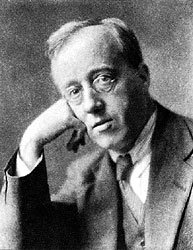 Having written conventional, mostly choral, pieces, and few in established genres, his musical reputation was local and performances were rare. His career as a pianist had crashed at college when he developed neuritis so severe that he reportedly could write music only by tying a pen nib to his forefinger. Despite asthma, he had earned his living playing the trombone in a Scottish orchestra and then by teaching at a girls' school. When war broke out, as James Lyons put it, he "tried to do his bit" but "no agency had any use for a fortyish musician who could not see six yards ahead of him with his spectacles on." Thus the world was hardly prepared for the innovative and eclectic Planets, which seemingly arose from a near-void and, much to the composer's frustration, despite his variegated output came to define him as a "one-hit wonder."
Having written conventional, mostly choral, pieces, and few in established genres, his musical reputation was local and performances were rare. His career as a pianist had crashed at college when he developed neuritis so severe that he reportedly could write music only by tying a pen nib to his forefinger. Despite asthma, he had earned his living playing the trombone in a Scottish orchestra and then by teaching at a girls' school. When war broke out, as James Lyons put it, he "tried to do his bit" but "no agency had any use for a fortyish musician who could not see six yards ahead of him with his spectacles on." Thus the world was hardly prepared for the innovative and eclectic Planets, which seemingly arose from a near-void and, much to the composer's frustration, despite his variegated output came to define him as a "one-hit wonder."
![]() Geoffrey Crankshaw paints Holst as both a visionary and a man of vast culture, such that the unique totality and universality of The Planets reflects all facets of his protean makeup. Commentators count among its many and diverse influences: the flexible rhythms of Thomas Morley and other English madrigalists (Douglas Lee); Berlioz's seminal Treatise on Orchestration which Holst absorbed and used as a springboard to discover sonorities of astounding originality (Harry Holbreich); Debussy's expanded orchestral palette that broke the grip of Teutonic standards upon English music (Lewis Foreman); the orchestral power and rhythmic vigor of Stravinsky's Rite of Spring (Len Mullinger); the tension and crossing between the fading Edwardian spirit (as embodied in formal education) and the rising Jazz Age (as reflected in kaleidoscopic student vulgarity) (Richard Greene); the idealistic philosophies of Walt Whitman and William Morris (Colin Matthews); a blend of Hindu philosophy and English folksong that set Holst on a path far from the mainstream of traditional European form in which his early works reveal a thorough grounding (Matthews); and exploration of folk music and modes of eastern scales and rhythms that induced individual flavors and an escape from Anglo-German melody (Arthur Hutchings).
Geoffrey Crankshaw paints Holst as both a visionary and a man of vast culture, such that the unique totality and universality of The Planets reflects all facets of his protean makeup. Commentators count among its many and diverse influences: the flexible rhythms of Thomas Morley and other English madrigalists (Douglas Lee); Berlioz's seminal Treatise on Orchestration which Holst absorbed and used as a springboard to discover sonorities of astounding originality (Harry Holbreich); Debussy's expanded orchestral palette that broke the grip of Teutonic standards upon English music (Lewis Foreman); the orchestral power and rhythmic vigor of Stravinsky's Rite of Spring (Len Mullinger); the tension and crossing between the fading Edwardian spirit (as embodied in formal education) and the rising Jazz Age (as reflected in kaleidoscopic student vulgarity) (Richard Greene); the idealistic philosophies of Walt Whitman and William Morris (Colin Matthews); a blend of Hindu philosophy and English folksong that set Holst on a path far from the mainstream of traditional European form in which his early works reveal a thorough grounding (Matthews); and exploration of folk music and modes of eastern scales and rhythms that induced individual flavors and an escape from Anglo-German melody (Arthur Hutchings).
 An Astrologer Casting a Horoscope Robert Fludd (1617) |
The most widely-mentioned influence, hardly surprising from the very titles of the individual movements, is astrology. On a holiday in 1913 Holst became enamored of What Is the Horoscope and How Is It Cast, one of several books in which Alan Leo attempted to popularize, modernize and systematize astrology as a scientific practice concerned with the delineation of character rather than prediction. In keeping with Leo's guidance, Malcolm Sargent, a close associate, recalled that Holst didn't believe in astrology as being prophetic, but rather was attracted by the notion of each planet shedding rays of influence upon the earth and mankind. Burnett James adds that while traditional astrology attempts to predict individual destiny from one's time and place of birth, Holst was more intrigued by the associative emotional connotations of each planet and in particular the psychological attributes that Leo ascribed to each planet (although Leo later would come to consider the sun to be dominant). Holst's daughter Imogen recalled that while Holst did cast horoscopes for friends, he was less interested in fortune-telling than in understanding human behavior. In any event Holst denied that horoscopes had anything to do with The Planets but rather that, as the underlying idea of astrology, "the character of each planet suggested lots to me" and that he regarded the universe as "one big miracle." Greene adds that Holst regarded planetary influence as a metaphor for various aspects of human personality and through each movement of The Planets sought to portray psychological drama within aspects of human character. 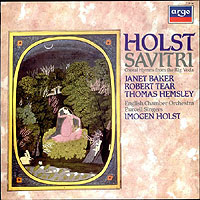 Yet Foreman notes that Holst's interest in astrology began to fade following The Planets, which perhaps was just as well, as Leo himself was convicted under the British Witchcraft Act shortly before his death in 1917.
Yet Foreman notes that Holst's interest in astrology began to fade following The Planets, which perhaps was just as well, as Leo himself was convicted under the British Witchcraft Act shortly before his death in 1917.
A more distant inspiration came from Holst's fascination with Hindu philosophy and Sanskrit literature. At first he wanted to set to music a group of hymns from the Rig Veda, the oldest Hindu text, but "finding the English translations he discovered were hopelessly stilted, Holst decided to learn Sanskrit so that he could translate the words to his own satisfaction. In doing so, he opened an entirely new world for himself." (Ian Lane) As with English madrigals and folk songs, Holst was fascinated by the use in Eastern music of non-Western scales, spare textures and unconventional time signatures of 5, 7 and even 21 beats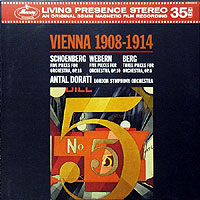 (which he declared were more suitable for setting English words) and incorporated those features into two operas and dozens of settings of Indian religious texts. While none attracted much notice or met with any appreciable success, their underlying character would permeate The Planets.
(which he declared were more suitable for setting English words) and incorporated those features into two operas and dozens of settings of Indian religious texts. While none attracted much notice or met with any appreciable success, their underlying character would permeate The Planets.
But perhaps the most direct musical influence was Arnold Schoenberg's 1909 Fünf Orchesterstücke (Five Orchestral Pieces). Not only one of the very first compositions to renounce tonal anchors and modulation in favor of extensive dissonance (but prior to tone rows), it used a huge orchestra, yet deployed with discretion to create a kaleidoscope of unusual textures within a highly expressionistic set of moods. As Schoenberg put it in his own anarchistic program note: "The music seeks to express all that swells in us subconsciously like a dream; which is a great fluctuant power, and is built upon none of the lines that are familiar to us; which has a rhythm, as blood has a pulsating rhythm, as all life in us has its rhythm; which has a tonality, but only as the sea or the storm has its tonality; which has harmonies, though we cannot grasp or analyze them nor can we trace its themes." After Holst heard it at a January 1914 London concert (at which it was largely despised by both audience and critics) he bought the score, heavily annotated it, and regarded it as one of his most valued possessions. Several commentators trace specific movements of The Planets to emulations of the atmosphere and orchestration in sections of Schoenberg's Pieces. Indeed, Holst's working title for The Planets on its first publication (along with his name as "von Holst," soon to be changed in deference to anti-German sentiment) was Seven Pieces for Large Orchestra.
![]() Holst composed The Planets over a course of two years, beginning in the summer of 1914 with Mars and continuing through the other movements in order, except for Mercury which he wrote last. He drafted it as a two-piano score during weekends in a soundproof room at St. Paul's Girls' School in Hammersmith where he taught and, due to his neuritis, upon whose students he relied to perform his sketches and write out the orchestral score according to his directions.
Holst composed The Planets over a course of two years, beginning in the summer of 1914 with Mars and continuing through the other movements in order, except for Mercury which he wrote last. He drafted it as a two-piano score during weekends in a soundproof room at St. Paul's Girls' School in Hammersmith where he taught and, due to his neuritis, upon whose students he relied to perform his sketches and write out the orchestral score according to his directions.
While each individual movement has unique and fascinating import, the overall structure is significant as well.  Foreman posits that the progression parallels the ages of man, from youth to old age. Greene sees a similar but psychological progression from life in the physical, profligate world to a mystical, stoic state. Matthews hears a range of aspects of Holst's (and, perhaps more generally, human) personality, from the quicksilver elusiveness of Mercury and extroversion of Jupiter to the relaxed lyricism of Venus and remote mystery of Neptune. Halbrick notes that the form moves from tightly structured to more open-ended. Even within each movement, Holst does not organically develop his themes symphonically, but rather uses them to create a structure suited to the psychological character and associations of each planet. In any event, Greene concludes that The Planets functions on a metaphoric level, presenting a succession of "mood pictures" rather than programmatic depiction.
Foreman posits that the progression parallels the ages of man, from youth to old age. Greene sees a similar but psychological progression from life in the physical, profligate world to a mystical, stoic state. Matthews hears a range of aspects of Holst's (and, perhaps more generally, human) personality, from the quicksilver elusiveness of Mercury and extroversion of Jupiter to the relaxed lyricism of Venus and remote mystery of Neptune. Halbrick notes that the form moves from tightly structured to more open-ended. Even within each movement, Holst does not organically develop his themes symphonically, but rather uses them to create a structure suited to the psychological character and associations of each planet. In any event, Greene concludes that The Planets functions on a metaphoric level, presenting a succession of "mood pictures" rather than programmatic depiction.
A related facet is the extent to which each movement relates to its titular god. As several commentators have pointed out, while some of the mythological references seem appropriate (Mars, Holst's "Bringer of War," indeed was the Roman god of war), others seem obscure (Neptune, Holst's "Mystic," was merely the sea god). Beyond that, the two most significant "planets" in casting horoscopes – the sun and the moon – are left out altogether. In a program note for the 1920 public premiere, Holst himself commented: "These pieces were suggested by the astrological significance of the planets; there is no programme music in them, neither have they any connection with the deities of classical mythology bearing the same names. If any guide to the music is required the subtitle to each piece will be found sufficient, especially if it be used in a broad sense." He gave as an example: "Mercury is the symbol of mind." Three months earlier Edwin Evans had expanded on this outlook in a Musical Times article, presumably with the composer's authority: "The generally accepted astrological associations of the various planets are a sufficient clue in themselves to the imagination. … [O]nce these relations are established in the titles of the movements, it is easy to fall into the mood of the respective tone poems. That is, in fact, the way to describe this work.  It has outrun the dimensions of a suite, and become a cycle of tone poems." Others, though, question the semblance of The Planets to prior tone poems, as they note that it is far longer than such typical single-movement works or even Debussy's La Mer or Nocturnes (Matthews), nor a collection of short pieces (like Mussorgsky's Pictures at an Exhibition or Elgar's Enigma Variations) (Matthews), and a far less literal depiction than the tone poems of Strauss or Delius (Lee). Moving beyond philosophical and astrological implications, Richard Freed concludes that The Planets is just as much about the character of the modern orchestra itself than having any extrinsic meaning.
It has outrun the dimensions of a suite, and become a cycle of tone poems." Others, though, question the semblance of The Planets to prior tone poems, as they note that it is far longer than such typical single-movement works or even Debussy's La Mer or Nocturnes (Matthews), nor a collection of short pieces (like Mussorgsky's Pictures at an Exhibition or Elgar's Enigma Variations) (Matthews), and a far less literal depiction than the tone poems of Strauss or Delius (Lee). Moving beyond philosophical and astrological implications, Richard Freed concludes that The Planets is just as much about the character of the modern orchestra itself than having any extrinsic meaning.
Indeed, Holst's orchestration is often cited as a prime glory of The Planets. Foreman notes that Holst's experience as a trombonist gave him a practical understanding of the orchestra from the inside that came to characterize the flair and brilliance of his instrumentation, of which several critics hail in particular the uncommonly radiant brass writing; Lee notes in particular the novelty of including the unusual timbres of the alto flute, bass oboe and tenor tuba. Sargent salutes the essential clarity of Holst's scoring (derived in part from his admiration for Ravel), and notes that after a score had been written Holst routinely would go through it with an eraser to expunge inessential notes and even entire instrumental lines. Imogen emphasized that "clarity was his watchword," that "he never could understand slovenly workmanship" and "though his music dwells in mystical regions yet it is never indefinite or shadowy." Yet she even suggests that "it may be a fault that it is too clear-cut, … a sharp outline when perhaps a vague impression would have sufficed," which Hutchings attributes to Holst's peculiar psychosis of austerity. As the result of this reticence, Crankshaw asserts that the mighty force of Holst's augmented orchestra "is used with such discrimination that the overall impression is not of Straussian sumptuousness but of many-stranded colour-schemes which coalesce only occasionally into full emblazonment." Freed similarly credits Holst with innovation beyond the scoring of his predecessors: "His vast forces are deployed with the utmost imaginative flair to achieve the most delicate and subtle effects and always with the feeling of great wells of strength in reserve." Matthews agrees that "Holst's ability to write succinctly and without overstaging the natural development of his material, and to sustain this invention over 50 minutes, is what makes The Planets such a remarkable achievement."
![]() Sargent considers it a consequence of Holst's characteristic modesty that, after completing The Planets, he made no effort to get it performed, although Imogen felt that her father had no reason to believe that the necessary forces could be assembled in the austerity of wartime. But he didn't seem fazed – she also reported that he said: "It's a great thing to be a failure. If nobody likes your work, you have to go on just for the sake of the work. … Every artist ought to pray that he may not be 'a success.'" Even so, Henry Balfour Gardiner, a wealthy concert promoter who advocated British works, arranged for a private performance on September 29, 1918 with the Queen's Hall Orchestra to be led by Adrian Boult as a gift prior to Holst's departure for Salonika to arrange musical entertainment for troops.
Sargent considers it a consequence of Holst's characteristic modesty that, after completing The Planets, he made no effort to get it performed, although Imogen felt that her father had no reason to believe that the necessary forces could be assembled in the austerity of wartime. But he didn't seem fazed – she also reported that he said: "It's a great thing to be a failure. If nobody likes your work, you have to go on just for the sake of the work. … Every artist ought to pray that he may not be 'a success.'" Even so, Henry Balfour Gardiner, a wealthy concert promoter who advocated British works, arranged for a private performance on September 29, 1918 with the Queen's Hall Orchestra to be led by Adrian Boult as a gift prior to Holst's departure for Salonika to arrange musical entertainment for troops. 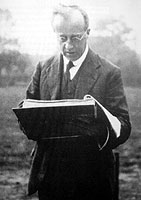 Holst's students hurriedly copied the parts and only two hours of rehearsal were available. Boult also led the first public performance on February 27, 1919, while Holst still was away, but omitted the final two serene movements (perhaps in part to save the cost of the wordless female chorus that makes its only appearance at the end of Neptune). As Foreman notes, the resulting torso left an impression of undue heaviness. In the Arts Gazette, Dunton Green observed: "It was an injustice to the composer to rob his planetary system of the two stars whose soft light would have relieved the fierce glare of the five others." Critical response was divided, some considering The Planets superficial and noisy while others found it vital and imaginative.
Holst's students hurriedly copied the parts and only two hours of rehearsal were available. Boult also led the first public performance on February 27, 1919, while Holst still was away, but omitted the final two serene movements (perhaps in part to save the cost of the wordless female chorus that makes its only appearance at the end of Neptune). As Foreman notes, the resulting torso left an impression of undue heaviness. In the Arts Gazette, Dunton Green observed: "It was an injustice to the composer to rob his planetary system of the two stars whose soft light would have relieved the fierce glare of the five others." Critical response was divided, some considering The Planets superficial and noisy while others found it vital and imaginative.
Indeed, excerpting the full work became prevalent. The first full public performance had to await October 10, 1920. In the interim, Holst himself conducted just Venus, Mercury and Jupiter in April 1919 at Queen's Hall and Henry Wood led the same movements that December, setting a precedent that would be followed for several years until the full orchestral score was published in late 1921. Lee admits some logic to certain selections, analogizing the progression of Mars, Venus, Mercury and Jupiter to a conventional four-movement symphony. David Trippett observes that The Planets's popularity soared as conductors vied with each other to present local premieres; one such dispute was settled when orchestras in Chicago and New York agreed to introduce The Planets to North America on the same night. As compiled by Greene, once the entire work was heard, many critics condemned reductions to mere excerpts and were generally ecstatic in praising the immediacy, eloquence, clarity of expression, originality and importance of the entire work (although he further attributes the devotion of English critics to a reflection of national pride, whereas others' views were more tempered, with some dwelling on its derivative nature and one dismissing it as "an anthology of musical platitudes.")
Perhaps in keeping with his visionary outlook and disdain for fame, unlike nearly all other composers Holst thwarted popular expectation by resisting the temptation to follow The Planets with a successor of a similar structure or style. In that regard, Matthews considers him the most original English composer, with a capacity for self-renewal, constitutionally incapable of repeating himself. Rather, he continued to work in a wide variety of styles, albeit slowed by a concussion he suffered in 1923. None of his further works caught much attention from colleagues or the public; although often austere and still heavily weighted toward vocal pieces, they included operas, fugal and double concertos, a choral symphony, orchestral, chamber and piano works and even a self-descriptive 1932 "Jazz Band Piece."
![]() Holst's work comprises seven movements, each devoted to a particular planet in our solar system (excluding the earth, the focus of the other planets' influences), beginning with the inner three but in reverse order from their distance from the sun, and then proceeding outwards through the rest.
Holst's work comprises seven movements, each devoted to a particular planet in our solar system (excluding the earth, the focus of the other planets' influences), beginning with the inner three but in reverse order from their distance from the sun, and then proceeding outwards through the rest.
Mars, the Bringer of War – Holst wastes no time launching his Planets with startling gestures. The overall tone is militaristic in sharp, percussive, insistent ostinato 5/4 time.  Rare enough in Western music, Holst's rhythm is neither the smooth "loping waltz" of the Tchaikovsky "Pathetique Symphony" nor the teasing bounce of Paul Desmond's "Take Five" nor even the urgent thrust of Ginger Baker's "Do What You Like." Rather, it projects a sense of jagged complication, driven forward by a beat of eighth notes yet stumbled by another beat of triplets, a rhythm that is challenging to follow and that defeats with faltering indecision any notion of regularity or feeling of stability. A callous texture is imposed by having the strings play the ostinato col legno (using the wooden back of the bow rather than the hair – hardly a favorite technique of artists cherishing their precious instruments), with the harps providing a cavernous edge by playing along in their lowest register. James deems the hollow-sounding emptiness as "catching exactly the brutal violence of all fighting" and Denis Stevens as "a premonition of total disaster." The theme itself lingers in bitterness, its constant leaps creeping downward in minor seconds to form tritones, and its rhythm nervous, sounding as though it should fit into 6/4 time but with the fourth beat forcibly extracted.
Rare enough in Western music, Holst's rhythm is neither the smooth "loping waltz" of the Tchaikovsky "Pathetique Symphony" nor the teasing bounce of Paul Desmond's "Take Five" nor even the urgent thrust of Ginger Baker's "Do What You Like." Rather, it projects a sense of jagged complication, driven forward by a beat of eighth notes yet stumbled by another beat of triplets, a rhythm that is challenging to follow and that defeats with faltering indecision any notion of regularity or feeling of stability. A callous texture is imposed by having the strings play the ostinato col legno (using the wooden back of the bow rather than the hair – hardly a favorite technique of artists cherishing their precious instruments), with the harps providing a cavernous edge by playing along in their lowest register. James deems the hollow-sounding emptiness as "catching exactly the brutal violence of all fighting" and Denis Stevens as "a premonition of total disaster." The theme itself lingers in bitterness, its constant leaps creeping downward in minor seconds to form tritones, and its rhythm nervous, sounding as though it should fit into 6/4 time but with the fourth beat forcibly extracted.
 The theme and 5/4 rhythm of Mars |
Beyond the resemblance of Mars to the first movement of Schoenberg's Suite, Mullenger asserts the influence of Stravinsky's Rite of Spring (although the savage climax of that work thrives on thoroughly erratic downbeats rather than the rigid, relentless rhythm here). Returning to the militant overtones, Kennedy, though, calls it not a rite of Spring but of Armageddon. Apparently referring to a rapid triplet figure, Sargent envisions the planet Mars, "laughing in shouts of exultant ferocity," as it soars over the turmoil of mankind's hatred, anger, violence and destruction. Such associations aside, in purely musical terms the movement begins in a soft piano menace, builds to a terrifying triple forte (fff) climax as instruments pile on, is halted by a massive discord followed by a slower 5/2 section still "haunted by the martial rhythm" after which the opening "returns with increased, almost hysterical, ferocity, ending with grinding chords" (Kennedy) as strings, brass and tympani dissonantly pound out the initial figure quadruple forte (ffff) as its rhythm finally disintegrates.
Why did Holst launch The Planets with Mars? Burnett James paints Holst as a lonely and tragic figure, assailed with agonizing spiritual blight and a bleak despair that enveloped his whole being (and which ultimately led him to increasingly dissociate his later music from emotion). Was Holst implying that the predominant psychosis of mankind, from which all human activity flowed, was steeped in and governed by aggression, hostility and conflict (hardly a surprising outlook on the brink of a war that threatened to be of unprecedented scope and destruction)? If so, then the rest of The Planets, both psychologically and musically, can be heard as proposing various paths to redemption or, perhaps collectively, a fervent prayer that mankind would find some way to carry on by embracing our better sides.
Venus, the Bringer of Peace – To Leo, Venus represents affection, devotion, an even disposition, a refined nature and a keen appreciation of art and beauty, in contrast to Holst's subtitle which suggests simplification to a single attribute. Silencing the organ, percussion, trumpets, trombones and tuba, Holst 's texture "concentrates on delicate and lucid tone colors" of woodwinds, harps, celesta and solo violin (Halbreich), creating "an essay in benignity" in which "our feet have been placed in some posture of security" (Crankshaw), "bringing to the suffering world a vision of heavenly peace" as Venus "sails softly across the evening sky, bringing with her a still, starlit repose" (James) and "the skies are soothed by a gentle benediction" (Freed). In every respect – its slower pace, lighter instrumentation, supple rhythm, gently oscillating chords, restricted dynamics and soothing harmonic motion – Holst's Venus provides a striking contrast to Mars (emulating a comparable shift in the Schoenberg Suite) and serves to reorient us toward a sense of human dignity that subtly evokes the qualities in Leo's attribution. Yet the harmonies are bitter-sweet and the themes are fragmented, suggesting that repose is at best temporary and that far more challenges remain in the human journey.
devotion, an even disposition, a refined nature and a keen appreciation of art and beauty, in contrast to Holst's subtitle which suggests simplification to a single attribute. Silencing the organ, percussion, trumpets, trombones and tuba, Holst 's texture "concentrates on delicate and lucid tone colors" of woodwinds, harps, celesta and solo violin (Halbreich), creating "an essay in benignity" in which "our feet have been placed in some posture of security" (Crankshaw), "bringing to the suffering world a vision of heavenly peace" as Venus "sails softly across the evening sky, bringing with her a still, starlit repose" (James) and "the skies are soothed by a gentle benediction" (Freed). In every respect – its slower pace, lighter instrumentation, supple rhythm, gently oscillating chords, restricted dynamics and soothing harmonic motion – Holst's Venus provides a striking contrast to Mars (emulating a comparable shift in the Schoenberg Suite) and serves to reorient us toward a sense of human dignity that subtly evokes the qualities in Leo's attribution. Yet the harmonies are bitter-sweet and the themes are fragmented, suggesting that repose is at best temporary and that far more challenges remain in the human journey.
Mercury, the Winged Messenger – Leo describes Mercury as colorless and adaptable,![]() absorbing the essence of those it contacts. Perhaps for that reason Holst wrote it last, rather than in order as with all the other movements, so that it could subsume the qualities of his other planets. The shortest movement at nearly four minutes, about half the length of the others, and with the fastest tempo (vivace), it flits between distant keys (B-flat and E) and duple and triple meters as its motif (barely a theme – Foreman calls it "a fragment from some half-remembered folk tune") careens among various instruments in delightfully transparent scoring. Often analogized to a symphonic scherzo, it's light, agile, playful and fully reflects an active mind eagerly searching for meaning amid disparate sources. Greene suggests that Holst, born under the sign of Virgo, was ruled by Mercury, and indeed credits his curiosity and intellect to the mental attributes of that planet (even though his approach to composition was methodical rather than spontaneous). Boult calls it "a perfect impression of winged lightness" and its harmonic ambivalence "a wonderful sense of elusiveness as of quicksilver."
absorbing the essence of those it contacts. Perhaps for that reason Holst wrote it last, rather than in order as with all the other movements, so that it could subsume the qualities of his other planets. The shortest movement at nearly four minutes, about half the length of the others, and with the fastest tempo (vivace), it flits between distant keys (B-flat and E) and duple and triple meters as its motif (barely a theme – Foreman calls it "a fragment from some half-remembered folk tune") careens among various instruments in delightfully transparent scoring. Often analogized to a symphonic scherzo, it's light, agile, playful and fully reflects an active mind eagerly searching for meaning amid disparate sources. Greene suggests that Holst, born under the sign of Virgo, was ruled by Mercury, and indeed credits his curiosity and intellect to the mental attributes of that planet (even though his approach to composition was methodical rather than spontaneous). Boult calls it "a perfect impression of winged lightness" and its harmonic ambivalence "a wonderful sense of elusiveness as of quicksilver."
Jupiter, the Bringer of Jollity – By far the most accessible of the movements, Jupiter is an unabashed celebration of life, fortune and hope in a multitude of forms.
Jupiter is an unabashed celebration of life, fortune and hope in a multitude of forms.
|
The main and hymn-like themes of Jupiter |
Saturn, the Bringer of Old Age – The optimism of Jupiter ![]() meets its opposite extreme in this terrifying depiction of the inevitability of life receding. Holst considered Saturn his favorite movement, perhaps in reaction to its negative press reviews or because, as Greene observes, his personality led him to identify with its traits of plodding perseverance, diffidence, apathy and endurance, all of which are reflected in the musical grammar. Thus Greene contends that the slow tempo reflects the pace of the aged, the oscillating chords hold tonal progression in abeyance as a symbol of timelessness, the gradual accumulation of tonality suggests steady progress, and the final tune sounds cold and arid, to which might be added that the constant syncopation tempers inevitability with unease. Imogen recalled that the slow alternating dissonant chords (emulating the third of Schoenberg's Pieces) reflect Holst being enthralled by the solemn tolling before services at Durham Cathedral of bells rung by two very old men in black gowns, thus generating the association with old age. Mullenger further hears the climactic syncopated gasps as recalling Holst's asthma and his struggling for breath as a child. Saturn is variously described as Holst at his most poignant, unfolding the decay and senility of old age against a constant reminder of unremitting time and awaiting destiny (Sargent), depicting the futility of rebellion against the inexorable onset of age and its varied portents (Freed) and an altogether extraordinary piece of musical realism (James). Yet Holst considered its message to be not only physical decay but a vision of fulfillment, and indeed in the subdued coda the frustration and angst of inevitable decline melts into acceptance.
meets its opposite extreme in this terrifying depiction of the inevitability of life receding. Holst considered Saturn his favorite movement, perhaps in reaction to its negative press reviews or because, as Greene observes, his personality led him to identify with its traits of plodding perseverance, diffidence, apathy and endurance, all of which are reflected in the musical grammar. Thus Greene contends that the slow tempo reflects the pace of the aged, the oscillating chords hold tonal progression in abeyance as a symbol of timelessness, the gradual accumulation of tonality suggests steady progress, and the final tune sounds cold and arid, to which might be added that the constant syncopation tempers inevitability with unease. Imogen recalled that the slow alternating dissonant chords (emulating the third of Schoenberg's Pieces) reflect Holst being enthralled by the solemn tolling before services at Durham Cathedral of bells rung by two very old men in black gowns, thus generating the association with old age. Mullenger further hears the climactic syncopated gasps as recalling Holst's asthma and his struggling for breath as a child. Saturn is variously described as Holst at his most poignant, unfolding the decay and senility of old age against a constant reminder of unremitting time and awaiting destiny (Sargent), depicting the futility of rebellion against the inexorable onset of age and its varied portents (Freed) and an altogether extraordinary piece of musical realism (James). Yet Holst considered its message to be not only physical decay but a vision of fulfillment, and indeed in the subdued coda the frustration and angst of inevitable decline melts into acceptance.
Uranus, the Magician – Reflecting the astrological realm of eccentricity and the occult, Holst's Uranus has been compared to Dukas's 1897 Sorcerer's Apprentice in terms of their structure, orchestration, rhythm and overall aura of comic bumbling within a serious setting, even though Boult insists that Holst had never heard it. A second scherzo of sorts, its tone harks back to the fourth movement of the Schoenberg Suite. Sargent sees it as confounding logic, working miracles divorced from reality. It begins with a portentious brass fanfare that quickly evolves into a jaunty but somewhat erratic pair of tunes that careen through the orchestra in constantly-changing patterns of sound that seem to involve every instrument from tympani to piccolo in wildly inventive combinations, as though conjured by a shambling yet potent sorcerer, as if to suggest that, once untethered from reality, all becomes possible. The full orchestra winds up "in a bubbling cauldron of sound" (Crankshaw) only to vanish with a massive pained tutti chord as "a sudden deflated collapse … into a dismal heap of nothingness" (James). After a brief backward glance and a massive organ pedal point, a few fragments of the spirited theme linger as "faint stars in a silent void to prepare us for the final vision" (Freed). A more remote but intriguing interpretation evokes the tower in tarot, consistent with the Biblical Tower of Babel, representing the need to destroy the old in order to wrest freedom from the resulting chaos.
Holst's Uranus has been compared to Dukas's 1897 Sorcerer's Apprentice in terms of their structure, orchestration, rhythm and overall aura of comic bumbling within a serious setting, even though Boult insists that Holst had never heard it. A second scherzo of sorts, its tone harks back to the fourth movement of the Schoenberg Suite. Sargent sees it as confounding logic, working miracles divorced from reality. It begins with a portentious brass fanfare that quickly evolves into a jaunty but somewhat erratic pair of tunes that careen through the orchestra in constantly-changing patterns of sound that seem to involve every instrument from tympani to piccolo in wildly inventive combinations, as though conjured by a shambling yet potent sorcerer, as if to suggest that, once untethered from reality, all becomes possible. The full orchestra winds up "in a bubbling cauldron of sound" (Crankshaw) only to vanish with a massive pained tutti chord as "a sudden deflated collapse … into a dismal heap of nothingness" (James). After a brief backward glance and a massive organ pedal point, a few fragments of the spirited theme linger as "faint stars in a silent void to prepare us for the final vision" (Freed). A more remote but intriguing interpretation evokes the tower in tarot, consistent with the Biblical Tower of Babel, representing the need to destroy the old in order to wrest freedom from the resulting chaos.
Neptune, the Mystic – Psychics revere Neptune as a primary influence that enables them to develop their skills to see beyond the visible. For the final movement Holst returns to the 5/4 time signature (which he specifies as 3 beats followed by 2, the same way the Mars rhythm is felt) that launched his Planets, but now, having probed the nobler aspects of the human condition, the militant hammering of Mars has fully ceded to a silken rustle. Indeed, Holst instructs: "The orchestra is to play sempre pp throughout" [somewhat redundantly – sempre means "throughout"] and added "dead tone" to his personal score; as a result "it never rises above a whisper to transport us to the quiet ecstasy of the Contemplative" (Sargent). Halbreich calls its beauty remote, as "its quiet and silvery stream of sounds unfolds without the slightest … hint of any earthly sentiment. … We feel that a vast journey has transpired and – even more significantly – that a wider exploration awaits us" (Crankshaw).
that enables them to develop their skills to see beyond the visible. For the final movement Holst returns to the 5/4 time signature (which he specifies as 3 beats followed by 2, the same way the Mars rhythm is felt) that launched his Planets, but now, having probed the nobler aspects of the human condition, the militant hammering of Mars has fully ceded to a silken rustle. Indeed, Holst instructs: "The orchestra is to play sempre pp throughout" [somewhat redundantly – sempre means "throughout"] and added "dead tone" to his personal score; as a result "it never rises above a whisper to transport us to the quiet ecstasy of the Contemplative" (Sargent). Halbreich calls its beauty remote, as "its quiet and silvery stream of sounds unfolds without the slightest … hint of any earthly sentiment. … We feel that a vast journey has transpired and – even more significantly – that a wider exploration awaits us" (Crankshaw).
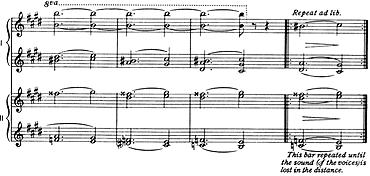 The indefinite ending (from the two-piano reduction) |
Although it has since become a cliché to depict outer space, Holst's inspired final touch is two wordless female choruses, each divided in thirds. While such a resource was not entirely novel (Debussy had already used wordless sopranos and altos to conclude his 1901 Sirènes), Holst's haunting indefinite ending was quite innovative. After all the other instruments fade away only the choruses are left repeating a mild cadence that never really resolves. Holst specifies: "This bar is to be repeated until the sound is lost in the distance." To achieve this, Holst further instructs: "The Chorus is to be placed in an adjoining room, … well-screened from the audience, … the door of which is to be left open until the last bar of the piece, when it is to be slowly and silently closed." Imogen confirms that Holst followed this directive in his own performances. Boult contends that "if it is possible for a piece of music never to finish, this is what happens here" and that the prolonged diminuendo following "this tuneless, expressionless, shapeless succession of cloudy harmonies, suggesting as it does an infinite vision of timeless eternity" makes us wonder if we still hear the chorus "or only hold them in our memory, swinging backward and forward for all time." Freed concludes that the impact is to "inhabit the outer regions of a fantasy infinity in which there are no answers and even the questions are unspoken."
![]() What about Pluto? Every elementary school student of my age knew as an undisputable fact that Pluto was the ninth planet in our solar system. The simple answer is that Pluto was only discovered and named in 1930, long after The Planets took final form. In retrospect that's just as well – in 2006, along with over 100 other celestial objects in the same region (the Kuiper Belt), Pluto was reclassified as a mere dwarf planet (for failure to meet a criterion of the definition of a planet – that its gravity dominates its neighborhood to capture as moons or clear away all other nearby objects). In the interim between Pluto's ascent and demise it must have seemed tempting to complete the task that Holst, by necessity, had left unfinished, while dissuaded from the heresy of tampering with the magical ending of Neptune.
What about Pluto? Every elementary school student of my age knew as an undisputable fact that Pluto was the ninth planet in our solar system. The simple answer is that Pluto was only discovered and named in 1930, long after The Planets took final form. In retrospect that's just as well – in 2006, along with over 100 other celestial objects in the same region (the Kuiper Belt), Pluto was reclassified as a mere dwarf planet (for failure to meet a criterion of the definition of a planet – that its gravity dominates its neighborhood to capture as moons or clear away all other nearby objects). In the interim between Pluto's ascent and demise it must have seemed tempting to complete the task that Holst, by necessity, had left unfinished, while dissuaded from the heresy of tampering with the magical ending of Neptune.
Pluto – Yet Colin Matthews rose to the task in 2000 on commission from the Hallé Orchestra. 
 In program notes he asserted that the only way to carry on was to avoid any break by beginning his new movement before Neptune fully fades (and so he modifies the original ending with a sustained violin harmonic that segues into his opening). The first half is soft and rather bitter, strewn with a few reminiscences of Holst's movements, and is described by Foreman as "a pianissimo world, a mercurial scurrying of chromatic runs and scales" in which "long-held very soft pedal points, evocative orchestral color, and the shining effect of harp and celesta all add to the almost tangible pictorial effect." But then a sudden explosion ushers in intense activity that, according to Matthew, uses solar winds as a starting point. Foreman continues: as quiet descends, "the distant vocalizing choir floats into our hearing again, as if it has been there throughout, and Matthews is back with Holst confronting the infinite." While Matthews claims that "in the process I came perhaps closer to Holst than I had expected," to me much of it sounds closer to Charles Ives. He does concede that Imogen Holst, to whose memory his Pluto is dedicated, "would have been both amused and dismayed by this venture."
In program notes he asserted that the only way to carry on was to avoid any break by beginning his new movement before Neptune fully fades (and so he modifies the original ending with a sustained violin harmonic that segues into his opening). The first half is soft and rather bitter, strewn with a few reminiscences of Holst's movements, and is described by Foreman as "a pianissimo world, a mercurial scurrying of chromatic runs and scales" in which "long-held very soft pedal points, evocative orchestral color, and the shining effect of harp and celesta all add to the almost tangible pictorial effect." But then a sudden explosion ushers in intense activity that, according to Matthew, uses solar winds as a starting point. Foreman continues: as quiet descends, "the distant vocalizing choir floats into our hearing again, as if it has been there throughout, and Matthews is back with Holst confronting the infinite." While Matthews claims that "in the process I came perhaps closer to Holst than I had expected," to me much of it sounds closer to Charles Ives. He does concede that Imogen Holst, to whose memory his Pluto is dedicated, "would have been both amused and dismayed by this venture."
Asteroids – And if Pluto was not enough to complete The Planets, in 2006 the Berlin Philharmonic commissioned four more pieces by diverse composers (from Finland, Germany, Britain and Australia) for an integral recording led by its music director, Simon Rattle (on an EMI CD). All are firmly in modern idioms and (to me, at least) seem to have no discernable connection, musical or otherwise, to the Holst work.
- Kaija Saariaho: Asteroid 4179: Toutatis – Saariaho's work at the IRCAM studio in Paris focused on the electronic manipulation of natural sounds.
 She was intrigued by Toutatis, the asteroid passing closest to earth, whose unusual shape and complex rotation causes its orientation to never repeat. Her four-minute piece comprises shifting layers of mildly altered instrument sounds in constant evolution within a rising and then falling arc of density and volume.
She was intrigued by Toutatis, the asteroid passing closest to earth, whose unusual shape and complex rotation causes its orientation to never repeat. Her four-minute piece comprises shifting layers of mildly altered instrument sounds in constant evolution within a rising and then falling arc of density and volume. - Matthias Pintscher: Towards Osiris – Known for his intricate construction and colorful textures, Pintscher invokes the classical myth of Osiris torn to pieces by his brother and then reassembled and revived by his wife swinging her massive wings. "This suggested to me a formal structure based upon various stages of fragmentation and reanimation: the initial state of completeness, the decomposition into separate pieces, and their reassembly and metamorphosis – a genuine musical process." Written on 60 staves, the textures are complex and evocative in their rapidly-shifting sounds.
- Marc-Anthony Turnage: Ceres – Turnage attributes to his Pentecostal upbringing a fear of Armageddon: "I was very attracted to the doomsday aspect of asteroids and the idea that the earth could be destroyed by one any day. … There are possibly two thousand asteroids big enough to imperil civilized existence. … The idea of the piece is that different blocks of material … gradually collide into a dense climactic section, then split apart."
- Brett Dean: Komarov's Fall – The final piece was written in memory of the first astronaut to die in space, possibly due to mechanical flaws that were overlooked under Soviet pressure for a grand political gesture. It begins with "the eerie, lonely beauty to be found in recordings of space telemetry signals," continues with the mounting panic of "Komarov's frantic discussions with the control centre," a bittersweet lyrical interlude as he speaks with his wife in farewell and panic mounting to the final explosion, and then wryly concludes with quiet flecks of random sound of an indifferent universe.
![]() Before considering orchestral recordings of The Planets, we should briefly note the original two-piano version. Yet unlike, say, Mussorgsky's Pictures at an Exhibition or Ravel's Tombeau de Couperin that were conceived for the keyboard and only later adapted for orchestra, Holst wrote the piano version of The Planets largely out of necessity and with the full intention of orchestrating it (and apparently with no thought of public performance, as it was only published posthumously). While the piano score is useful for study purposes, despite the technical excellence of several recordings the keyboard version unavoidably purges The Planets of all its color and texture. In theory the pipe organ can overcome much of this problem with its panoply of distinctive voices, awesome power and ability to preserve a sustained mood (especially in the atmospheric Neptune), but a version by Peter Sykes (on a 1996 Raven CD) all too often comes across as a homogeneous sonic blur compared to the original.
Before considering orchestral recordings of The Planets, we should briefly note the original two-piano version. Yet unlike, say, Mussorgsky's Pictures at an Exhibition or Ravel's Tombeau de Couperin that were conceived for the keyboard and only later adapted for orchestra, Holst wrote the piano version of The Planets largely out of necessity and with the full intention of orchestrating it (and apparently with no thought of public performance, as it was only published posthumously). While the piano score is useful for study purposes, despite the technical excellence of several recordings the keyboard version unavoidably purges The Planets of all its color and texture. In theory the pipe organ can overcome much of this problem with its panoply of distinctive voices, awesome power and ability to preserve a sustained mood (especially in the atmospheric Neptune), but a version by Peter Sykes (on a 1996 Raven CD) all too often comes across as a homogeneous sonic blur compared to the original.
The headnotes below list the conductor and the orchestra in bold (the choir's role is too brief to warrant mention), followed in parentheses by the year, original label and format and, if different, the reissue I heard. I must emphasize that this does not purport to be a comprehensive or definitive survey, as I've only focused on the pioneering recordings that strike me as having significant historical and stylistic interest. A far more inclusive, if highly opinionated, list is on the Peter's Planets website (no relation).
- Gustav Holst, London Symphony Orchestra (1922-4; Columbia 78s; Pearl CD) and (1926, Columbia 78s; EMI LP and CD)
Any meaningful consideration of Planets recordings begins here. 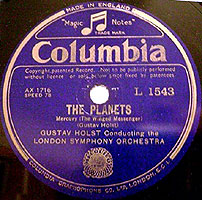
 Unlike Stravinsky, who recorded his seminal ballets only once his style had evolved radically from expressionist firebrand to detached neoclassicist, Holst began committing his Planets to disc a few years after its premiere, with the creative impulse presumably still fresh in his mind. Thus Holst's own recordings unquestionably provide the most authoritative document of how he intended The Planets to sound. Indeed his daughter Imogen insists upon their "characteristic authority. … The work sounds just as it did when Holst used to conduct it before a Queen's Hall audience," even though she allows that by having to record each side straight through "there may be details which Holst would have liked to improve, but the performance as a whole is a magnificent achievement."
Unlike Stravinsky, who recorded his seminal ballets only once his style had evolved radically from expressionist firebrand to detached neoclassicist, Holst began committing his Planets to disc a few years after its premiere, with the creative impulse presumably still fresh in his mind. Thus Holst's own recordings unquestionably provide the most authoritative document of how he intended The Planets to sound. Indeed his daughter Imogen insists upon their "characteristic authority. … The work sounds just as it did when Holst used to conduct it before a Queen's Hall audience," even though she allows that by having to record each side straight through "there may be details which Holst would have liked to improve, but the performance as a whole is a magnificent achievement."
Holst first recorded The Planets with the London Symphony in the acoustic process, in which sound was gathered in a horn directly coupled to the cutting stylus. Perhaps as a tentative test of its market appeal, Jupiter was cut on September 15, 1922 but not issued (as a two-sided 78) until March 1923. Apparently it was successful, as they returned in August 1923 for Venus, Uranus and Mercury (plus the "Marching Song" from Holst's Songs Without Words as a backing for Mercury, which fit on a single side) and completed the cycle with Mars in October, Neptune in November and Saturn in February 1924. Each movement was issued singly and then together in a seven-disc album. Imogen recalled: "He found it the most exhausting job he ever had to do, for the large orchestra was crowded into a comparatively small room, the string players were unable to draw their bows to the full length of a crescendo, and the superb horn player broke down 13 times at the beginning of Venus from the sheer discomfort of not having enough air to breathe." Even allowing her some degree of exaggeration, the technology surely did present daunting challenges – the size of the orchestra had to be drastically reduced, instruments were hard to distinguish when shorn of their highest overtones, string basses couldn't register at all, and dynamics had to be compressed to dwell between a floor of surface noise and a ceiling of distortion. Two movements apparently were remade, again acoustically, in 1925 with notably changed tempos – Saturn in February (slower) and Jupiter in September (faster). The reason is unclear – upon reflection did Holst feel a need to correct the original pacings, or perhaps were his own views capricious (and thus should not be taken by others as definitive)? In any event, benefiting from the greater range and flexibility of microphones, amplifiers and mixers, the electrical system soon rendered acoustic recordings obsolete. Using the new technology, Holst and the London Symphony rerecorded The Planets (plus Mercury's companion "Marching Song") between June and November 1926 (and, interestingly, he reverted to the faster tempo of the first acoustical Saturn).
Comparing Holst's two recordings, the second obviously has richer sound. I generally disparage those who routinely dismiss acoustical recordings as primitive and unworthy of attention (and thus ignore a crucial slice of our cultural heritage), but in this instance the electrical remake, coming soon after and fundamentally similar in approach, strikes me as superior, not only in terms of sonic fidelity and overcoming most of the compromises required by the tyranny of the earlier mechanism but in the quality of the execution and Holst's more assured leadership (even though, while lacking the skills and experience of a trained conductor, by 1922 he had led The Planets in public many times). That said, the first version has its merits, mainly in greater visceral excitement from its scrappier and more incisive playing, a more intimate sense of communication arising from its reduced forces, and even some striking details, beginning at the very outset as the col legno strings open Mars with rasping ferocity.
but in this instance the electrical remake, coming soon after and fundamentally similar in approach, strikes me as superior, not only in terms of sonic fidelity and overcoming most of the compromises required by the tyranny of the earlier mechanism but in the quality of the execution and Holst's more assured leadership (even though, while lacking the skills and experience of a trained conductor, by 1922 he had led The Planets in public many times). That said, the first version has its merits, mainly in greater visceral excitement from its scrappier and more incisive playing, a more intimate sense of communication arising from its reduced forces, and even some striking details, beginning at the very outset as the col legno strings open Mars with rasping ferocity.
What can we learn from these esteemed messengers? Heard today both versions startle immediately with their sheer overall speed – in comparison to modern recordings which tend to dwell around 50 minutes, the total timing of the first set is 44 and the remake is a mere 42½ (largely due to a much more animated Venus). Imogen called the tempos "a revelation" and gave as an example that although Venus is marked adagio, Holst's recordings suggest more of an andante (that is, only moderately slow). Such guidance is especially important, as Holst did not provide metronome markings; rather, he labeled his movements with the traditional vague Italian terms (Allegro for Mars, Adagio for the opening of Venus, etc.). Within the basic tempos Imogen calls his beat "clear and unfussy. … Rhythm to Holst was the most important thing in life, and in this recording he never for one moment allows the rhythm to sag, with the result that Mars sounds even more relentless than usual." Yet his tempos are not rigid but imbued with subtle elasticity to gently underline transitions and mood shifts. Balances, too, are notable, with the brass in particular striding atop the strings that often dominate early electrical recordings; Imogen notes as cogent details "the bells in Saturn, the xylophone in Uranus and the distant celesta in Neptune" which indeed are audible but not intrusive. Even so, she did express two reservations: that the end of Neptune is too abrupt (with only a single repetition of the closing bar) and that the final staccato chord in Mercury is much too loud, which she attributed to using too large a gesture in order to avoid a ragged attack, which would have required scrapping the whole side. Flaws aside, Holst is an enormously persuasive advocate for his Planets and either set affords the incomparable thrill of eavesdropping on a composer supplementing the cold written score to infuse his creation with the essence of his personal creative spirit.
- Albert Coates, Symphony Orchestra (Mars, Mercury, Jupiter and Uranus only) (1926; HMV 78s; Koch CD)
In a sure sign of sudden popularity,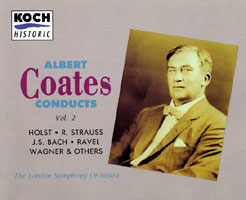 while Columbia seemingly dawdled to complete its sessions for the composer's set of electrical 78s, rival HMV prepared its own competing version, and with a fair degree of authenticity, as Coates had led the first (or, according to some sources, the second) full public performance. (While identified only as "Symphony Orchestra" on the original labels, the ensemble probably was the London Symphony, with which Coates was closely associated and with whose players he made most of his HMV recordings, even though it was contracted to Columbia.) Unfortunately, only Mars, Mercury, Jupiter and Uranus were recorded, perhaps to focus on the faster movements that were easiest to capture, would have the most popular appeal, would provide a marketing advantage by fitting onto four rather than seven discs, and seemed best matched to Coates's spontaneous musical temperament. Imogen reports that Holst hated incomplete performances (even though at first he had led several himself) and the result here gives a rather warped impression of Holst's concept; moreover, if the Coates set is played in the prescribed order, it closes with the end of Uranus that functions to set the mood for the true conclusion of Neptune and sounds tentative in isolation (although since the movements were on separate records their order could be rearranged, perhaps to end with the triumphant finale of Jupiter.)
while Columbia seemingly dawdled to complete its sessions for the composer's set of electrical 78s, rival HMV prepared its own competing version, and with a fair degree of authenticity, as Coates had led the first (or, according to some sources, the second) full public performance. (While identified only as "Symphony Orchestra" on the original labels, the ensemble probably was the London Symphony, with which Coates was closely associated and with whose players he made most of his HMV recordings, even though it was contracted to Columbia.) Unfortunately, only Mars, Mercury, Jupiter and Uranus were recorded, perhaps to focus on the faster movements that were easiest to capture, would have the most popular appeal, would provide a marketing advantage by fitting onto four rather than seven discs, and seemed best matched to Coates's spontaneous musical temperament. Imogen reports that Holst hated incomplete performances (even though at first he had led several himself) and the result here gives a rather warped impression of Holst's concept; moreover, if the Coates set is played in the prescribed order, it closes with the end of Uranus that functions to set the mood for the true conclusion of Neptune and sounds tentative in isolation (although since the movements were on separate records their order could be rearranged, perhaps to end with the triumphant finale of Jupiter.)
With deep roots, both parental and musical, in England and Russia, Coates absorbed the unabashed subjective outlook of his mentor Arthur Nikisch, who reportedly told him to trade his conductor's baton for a whip. Consistent with his other rousing recordings, he leads a full-blooded reading of The Planets, even faster than Holst's (except for the central Jupiter hymn) and with sharper contrasts and more emphatic climaxes. Thus his Mars exudes a snarling menace and gallops ahead as though chased by fear, his Mercury sweeps aside any sense of polished grace as it boils over with irrepressible energy, the instruments in Jupiter fairly explode in joy as they jostle for attention, and Uranus becomes a heart-pounding march that heightens the repose of its final minute. If Holst's recordings were meticulous translations of his score into sound, Coates's is a deeply inventive interpretation that opened the door for others to approach it fearlessly with their own notions of personal freedom.
- Ernest Macmillan, Toronto Symphony Orchestra (Mars, Venus, Mercury and Jupiter only) (1942; HMV 78s; digital download)
Despite their simultaneous appearance at the dawn of the era of electrical recording  (which would seem to suggest a hearty public appetite for more), the Holst and Coates sets appear to have sufficed to sate demand for 16 years. Only then did another appear, and from a rather obscure and unlikely source. Although Macmillan was a multi-talented composer, author and teacher who was cherished as Canada's foremost musician, he and the Toronto orchestra he raised to prominence and led for 25 years were barely known abroad and it is unclear why they cut the next Planets – and why only the first four movements. Macmillan is barely mentioned in the standard reference books and seems to have made very few recordings (and of those most were as an accompanist, including spirited Bach and Beethoven concertos with compatriot Glenn Gould), and so we have little basis to generalize his style. That said, he and his orchestra produced quite a credible performance. The fidelity (possibly goosed in digital transfers) is markedly improved over the predecessors', displays a greater realm of textures, especially in the delicate instrumental interplay of Venus, and allows finer appreciation of the magnitude of Holst's flair for colorful orchestration. Even so, the balance favors the strings to the detriment of the other choirs, such that the rapid accompanying violin figurations swamp the majestic brass introduction of the rousing Jupiter melody, and the tympani are barely heard at all. Tempos in Mars and Jupiter are significantly slower than with Holst or Coates, imbuing these movements with a deeper sense of drama (albeit at the expense of driven resolve) and in doing so elevates them yet further above the realm of standard program music. The album of four 78s was issued in automatic sequence (with a 1937 Boult/BBC Symphony Elgar "Imperial March" as the eighth side following the second half of Jupiter, rather than backing Mercury) and thus, unlike with the individual discs of the Holst and Coates sets, effectively prescribed that the movements were to be heard in order, wrapping up with the triumphant conclusion of Jupiter, even though Imogen reports that Holst particularly disliked such a false "happy ending."
(which would seem to suggest a hearty public appetite for more), the Holst and Coates sets appear to have sufficed to sate demand for 16 years. Only then did another appear, and from a rather obscure and unlikely source. Although Macmillan was a multi-talented composer, author and teacher who was cherished as Canada's foremost musician, he and the Toronto orchestra he raised to prominence and led for 25 years were barely known abroad and it is unclear why they cut the next Planets – and why only the first four movements. Macmillan is barely mentioned in the standard reference books and seems to have made very few recordings (and of those most were as an accompanist, including spirited Bach and Beethoven concertos with compatriot Glenn Gould), and so we have little basis to generalize his style. That said, he and his orchestra produced quite a credible performance. The fidelity (possibly goosed in digital transfers) is markedly improved over the predecessors', displays a greater realm of textures, especially in the delicate instrumental interplay of Venus, and allows finer appreciation of the magnitude of Holst's flair for colorful orchestration. Even so, the balance favors the strings to the detriment of the other choirs, such that the rapid accompanying violin figurations swamp the majestic brass introduction of the rousing Jupiter melody, and the tympani are barely heard at all. Tempos in Mars and Jupiter are significantly slower than with Holst or Coates, imbuing these movements with a deeper sense of drama (albeit at the expense of driven resolve) and in doing so elevates them yet further above the realm of standard program music. The album of four 78s was issued in automatic sequence (with a 1937 Boult/BBC Symphony Elgar "Imperial March" as the eighth side following the second half of Jupiter, rather than backing Mercury) and thus, unlike with the individual discs of the Holst and Coates sets, effectively prescribed that the movements were to be heard in order, wrapping up with the triumphant conclusion of Jupiter, even though Imogen reports that Holst particularly disliked such a false "happy ending."
- Adrian Boult, BBC Symphony (1945, HMV 78s; HMV Treasury LP); Philharmonic Promenade Orchestra [the London Philharmonic] (1954, Nixa LP); Vienna State Opera Orchestra (1962, Westminster LP); New Philharmonia (1967, EMI/Angel LP); London Philharmonic (1978, EMI)
Finally, nearly two decades after Holst's own electrical remake, the next complete Planets arrived. 
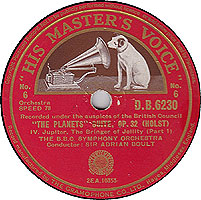 Boult had been a relative novice at conducting when he led the first private performance at the composer's request in 1918, but Holst clearly was pleased, later presenting Boult with the score inscribed: "This copy is the property of Adrian Boult who first caused the Planets to shine in public and thereby earned the gratitude of Gustav Holst." Throughout his career Boult remained a stalwart advocate of the work and set a record of sorts by cutting it five times in the studio (in addition to numerous preserved concerts). In notes to his 1967 recording, Boult expressed the hope that his BBC set "came near the composer's intentions" and that his subsequent recordings, while taking advantage of technical improvements, would "still sound faithful and authentic." In particular, he cautioned with respect to Mars: "I well remember the composer's insistence on the stupidity of war as well as all its other horrors, and I feel that the movement can easily be played so fast that it becomes too restless and energetic and loses some of its relentless, brutal and stupid power." Indeed, robbed of its usual quirky edge, his Mars is suffused with a world-weary air and casts a pall over the rest of the work that is never fully dispelled; its final chords seem weighed down with regret, aptly leading into a Venus that seems less an aura of peace than a futile plea. Boult's endings of the slow movements sound abruptly perfunctory, lending greater feeling to the extremely gradual fadeout of his Neptune.
Boult had been a relative novice at conducting when he led the first private performance at the composer's request in 1918, but Holst clearly was pleased, later presenting Boult with the score inscribed: "This copy is the property of Adrian Boult who first caused the Planets to shine in public and thereby earned the gratitude of Gustav Holst." Throughout his career Boult remained a stalwart advocate of the work and set a record of sorts by cutting it five times in the studio (in addition to numerous preserved concerts). In notes to his 1967 recording, Boult expressed the hope that his BBC set "came near the composer's intentions" and that his subsequent recordings, while taking advantage of technical improvements, would "still sound faithful and authentic." In particular, he cautioned with respect to Mars: "I well remember the composer's insistence on the stupidity of war as well as all its other horrors, and I feel that the movement can easily be played so fast that it becomes too restless and energetic and loses some of its relentless, brutal and stupid power." Indeed, robbed of its usual quirky edge, his Mars is suffused with a world-weary air and casts a pall over the rest of the work that is never fully dispelled; its final chords seem weighed down with regret, aptly leading into a Venus that seems less an aura of peace than a futile plea. Boult's endings of the slow movements sound abruptly perfunctory, lending greater feeling to the extremely gradual fadeout of his Neptune.
Otherwise, Boult's first outing has few unusual features. Yet while largely akin to the composer's own recordings in their dearth of personal interpretive quirks, their basic tempos diverge significantly. Not only does Boult's Mars run about a minute slower than Holst's, but his Jupiter, Saturn and Neptune do as well – appreciable differences that raise the intriguing question as to whether interpretations that differ from a composer's own can authentically represent the composer's intentions, as Boult claims his do, and not only with respect to their tempos – the very texture of Holst's Mars is aggressive whereas Boult's simply is not. Equally anomalous, in lieu of the general tempo slowdown common with conductors over the course of long careers, Boult's five studio Planets follow no pattern; thus, for example, his Saturn swings from 8:15 in 1945, to 8:53 in 1954, to 8:24 in 1960, to 9:09 in 1967, to 8:23 in 1978. His Mars careens among even greater extremes, from 7:17 (1945) to 6:41 (1954) to 8:02 (1978). While professing fealty to Holst's intentions, Boult clearly felt free to pursue a different course. That, in turn, suggests that the very notion of authenticity cannot be reduced to a single set of parameters and that great music can only be enriched by a range of personal interpretation.
That said, all of Boult's Planets recordings are splendid – except for the 1960 LP with the Vienna State Opera Orchestra which is crudely played with weak ensemble. Despite their varying tempos that defy the general trend of conductors adopting more autumnal outlooks as they age, Boult's Planets do generally tend to be progressively smoother, and, of course, the recording quality itself becomes more subtly detailed as the technology develops (although even the 1945 BBC rendition already exhibits a fine tonal blend and balance).
- Malcolm Sargent, London Symphony (1954, Decca LP); BBC Symphony (1958, HMV LP)
Concurrent with Boult's first remake,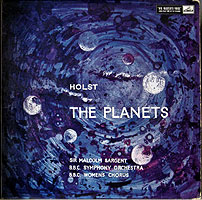
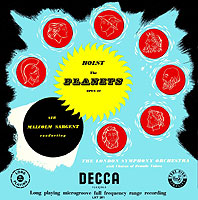 Decca issued a competing LP that, coming at the very end of the mono era, was soon superseded by a stereo version (albeit with a different orchestra), much as Holst's acoustical set had been promptly replaced by its electrical remake. Sargent was especially famed for his choral work from religious oratorios to Gilbert and Sullivan and, like Boult, was a lifelong advocate of British music. His Planets belies his reputation for levelheaded performances of precision and polish – that is, being more dependable than exhilarating – and in the process further dispels notions of Holst's own artistic temperament as methodical and cautious. Sargent's reading is remarkably potent, from a downright spooky opening as Mars seethes toward a giant climax, to alarmingly loud bells that shake off any sense of torpor in Saturn, and earth-shaking organ pedal points and huge tympani that magnify the drama of Uranus. But perhaps the most remarkable movement is Venus, in which Sargent adds another full minute to others' already sprawling pace to craft a feeling beyond mere wistful dreams to a lush romanticism that one would not have suspected to find within the composer's emotional arsenal.
Decca issued a competing LP that, coming at the very end of the mono era, was soon superseded by a stereo version (albeit with a different orchestra), much as Holst's acoustical set had been promptly replaced by its electrical remake. Sargent was especially famed for his choral work from religious oratorios to Gilbert and Sullivan and, like Boult, was a lifelong advocate of British music. His Planets belies his reputation for levelheaded performances of precision and polish – that is, being more dependable than exhilarating – and in the process further dispels notions of Holst's own artistic temperament as methodical and cautious. Sargent's reading is remarkably potent, from a downright spooky opening as Mars seethes toward a giant climax, to alarmingly loud bells that shake off any sense of torpor in Saturn, and earth-shaking organ pedal points and huge tympani that magnify the drama of Uranus. But perhaps the most remarkable movement is Venus, in which Sargent adds another full minute to others' already sprawling pace to craft a feeling beyond mere wistful dreams to a lush romanticism that one would not have suspected to find within the composer's emotional arsenal.
- Leopold Stokowski, Los Angeles Philharmonic (1956, Capitol LP, EMI CD)
In the meantime, between the two Sargent LPs, Stokowski produced the first stereo Planets, as well as the first by non-British forces. In 1944, drawing players from the Los Angeles Philharmonic, he had created an orchestra for the Hollywood Bowl and recorded a few short pieces with them at the time, but after that he returned only once to conclude their 1955 season. Perhaps that occasion prompted this recording, which appears to be his only one with the Los Angeles Philharmonic throughout his extraordinarily prolific career. In any event, for a work glorified for its magnificent orchestration it's hard to imagine a more suitable match than the conductor who, more than any other of his generation, reveled in instrumental color and was deeply involved in the recording process and the sheer sound of his records. 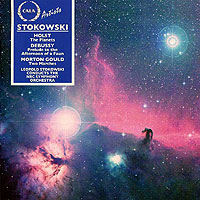
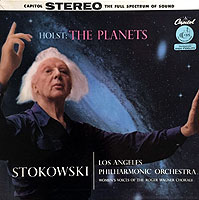 (True to form, Stokowski wrote a letter to the producer with detailed suggestions for improving a test pressing, including filtering out highs from "thin and metallic" trumpets and adding echo to Uranus as if it "came from a great cavern, extremely reverberant" so as to differentiate it from the rest, although neither effect is especially evident.) Rather surprisingly, while Saturn is engagingly atmospheric, much of the result turns out to be mellow and tasteful, with some disengaged playing and far less garish spotlighting of instrumental lines than we might expect. Even so, purists will quail at Stokowski's tampering with the score – he adds a mammoth gong to underline the final Mars chord (and a softer one during the Neptune female chorus), and concludes Neptune with a full, if quiet, cadence rather than trailing off into the infinite.
(True to form, Stokowski wrote a letter to the producer with detailed suggestions for improving a test pressing, including filtering out highs from "thin and metallic" trumpets and adding echo to Uranus as if it "came from a great cavern, extremely reverberant" so as to differentiate it from the rest, although neither effect is especially evident.) Rather surprisingly, while Saturn is engagingly atmospheric, much of the result turns out to be mellow and tasteful, with some disengaged playing and far less garish spotlighting of instrumental lines than we might expect. Even so, purists will quail at Stokowski's tampering with the score – he adds a mammoth gong to underline the final Mars chord (and a softer one during the Neptune female chorus), and concludes Neptune with a full, if quiet, cadence rather than trailing off into the infinite.
Stokowski shared the podium of the NBC Symphony for three seasons after Toscanini petulantly (if temporarily) resigned from "his" orchestra. Fortunately, a broadcast of their February 14, 1943 concert Planets has been preserved (on a Cala CD) that complements the studio version with an altogether more gripping account that wastes no time in staking its claim – ignoring Holst's piano dynamic marking, Stokowski plunges into Mars at full boil and never relents, building tension to the breaking point in each of its three sections and then proceeds to inject each of the following movements with heartfelt personal touches. Most tempos are inflated – the unhurried Venus and Saturn are considerably slower while the fleet Mercury and Jupiter are faster. Jupiter, in particular, careens amid super-charged tempos that the orchestra delivers with electrifying accuracy (but after all, it was used to Toscanini) and Uranus thrills as instruments jostle for attention. Even as enhanced to bring out detail for its digital transfer, the recording is a bit crude and dynamic compression raises the noise floor to cloak the fragile interplay of harps and celesta in Neptune, a sorely missed effect, as Stokowski bloats the final movement to nearly ten minutes (compared to a "normal" seven or so) and thus trades its inherent gentle momentum for a far different but equally apt sense of timeless suspension.
- Herbert von Karajan, Vienna Philharmonic (1961, Decca LP and CD)
Karajan's was the only other Planets
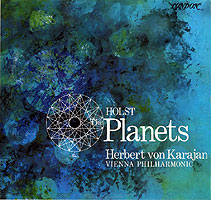 (aside from Boult and Sargent remakes) to emerge during the entire decade of the 'sixties. Depending upon one's vantage, Karajan's objective precision either lets the music speak for itself with intrinsic integrity or heartlessly drains it of human communication. While I'm not a fan of his desiccation of the Romantics, I do value the effectiveness of his approach to the impressionists and Viennese moderns, which also works here, where the clarity of execution, crisp accents and meticulous control of dynamics create a striking sense of atmosphere in the slow movements, matched by Decca's gloriously crisp and detailed ffrr recording that highlights some unusual sonorities, including the bass oboe in the opening and husky bells in the climax of Saturn. While Karajan closely follows the score, his tempos are significantly slower than Holst's and portions can seem mechanical, notably a humorless Jupiter in which the gear-shift for a ponderous central hymn seems an incongruous intrusion. Yet Karajan's approach sets a standard for the continuing modern trend of turning away from the sort of interpretive license that had been expected in the past but which has come to be considered crude by current orchestral (as opposed to solo) performance standards. In 1981 Karajan remade The Planets with his Berlin Philharmonic (DG LP and CD) but its slower pace is magnified by the midrange emphasis of the recording's tonal balance, which disserves the gleaming clarity of Holst's multi-faceted orchestration.
(aside from Boult and Sargent remakes) to emerge during the entire decade of the 'sixties. Depending upon one's vantage, Karajan's objective precision either lets the music speak for itself with intrinsic integrity or heartlessly drains it of human communication. While I'm not a fan of his desiccation of the Romantics, I do value the effectiveness of his approach to the impressionists and Viennese moderns, which also works here, where the clarity of execution, crisp accents and meticulous control of dynamics create a striking sense of atmosphere in the slow movements, matched by Decca's gloriously crisp and detailed ffrr recording that highlights some unusual sonorities, including the bass oboe in the opening and husky bells in the climax of Saturn. While Karajan closely follows the score, his tempos are significantly slower than Holst's and portions can seem mechanical, notably a humorless Jupiter in which the gear-shift for a ponderous central hymn seems an incongruous intrusion. Yet Karajan's approach sets a standard for the continuing modern trend of turning away from the sort of interpretive license that had been expected in the past but which has come to be considered crude by current orchestral (as opposed to solo) performance standards. In 1981 Karajan remade The Planets with his Berlin Philharmonic (DG LP and CD) but its slower pace is magnified by the midrange emphasis of the recording's tonal balance, which disserves the gleaming clarity of Holst's multi-faceted orchestration.
![]() After the relative handful of recordings during the first half-century of its existence, and nearly a decade after Karajan became the last outsider to break the British hegemony of artists, the marketing floodgates opened in the early 1970s with a sudden abundance of a half-dozen new Planets LPs, to be joined since then by dozens more. While lacking the patience or interest to attempt to hear them all (for that, please refer to the Peter's Planets site), two struck me of particular promise:
After the relative handful of recordings during the first half-century of its existence, and nearly a decade after Karajan became the last outsider to break the British hegemony of artists, the marketing floodgates opened in the early 1970s with a sudden abundance of a half-dozen new Planets LPs, to be joined since then by dozens more. While lacking the patience or interest to attempt to hear them all (for that, please refer to the Peter's Planets site), two struck me of particular promise:
- Bernard Herrmann, London Philharmonic (1970, Decca/London Phase 4 LP) – Primarily known for his film scores
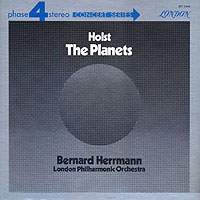 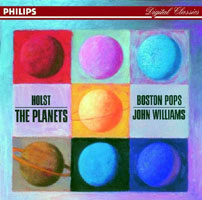 
|
- John Williams, Boston Pops (1986, Philips LP and CD) – Like Herrmann, Williams is famed as a film composer but, despite his vast celebrity and wealth, hardly as unique. Of particular relevance here, portions of his most famous score, for Star Wars, are strikingly similar to The Planets, and the two are even joined on several CDs, so I couldn't resist being intrigued. Indeed, Williams is a notorious "borrower" and not just from Holst. Admittedly, with so much music out there it's nearly impossible to be truly original anymore, and depending on your view of such matters, this increasingly prevalent practice lies somewhere along a complex moral scale from sheer coincidence to shameless plagiarism, with the respectful tribute of sampling, so intrinsic to hip-hop, lying somewhere in between. In any event, while a generation earlier the Boston Pops had turned out many credible recordings of serious repertoire (as well as plenty of spirited pop stuff) under Arthur Fiedler, and while Williams might have been expected to adorn The Planets with special insight or affection arising from his own compositions, his reading turns out to be competent but unexceptional. Kudos, though, for an eye-grabbing cover!
- Roy Goodman, The New Queen’s Hall Orchestra (1997, Carlton CD) – Renowned as a pioneer of the historically-informed performance movement that transformed our perspective on baroque, classical and early romantic music, Goodman here replicates an “original instrument” version of the Planets, played on wooden flutes, small-bore brass, gut-stringed violins and other genuine century-old instruments of the types actually heard in British orchestras of Holst’s time (and the sound of which he inevitably had in mind when writing The Planets). Frankly, the sonic differences with other modern recordings tend to be subtle. Yet, as James Reid points out, Goodman goes further by not only focusing on textures and balances but by adhering far closer than other conductors to the fundamental tempos of the composer’s own recordings (although not slavishly – he takes about two more minutes overall) and thereby presents an attractive option for those seeking to experience the original conception yet put off by the sound of Holst’s discs. (Reid also provides a fascinating take on The Planets from an astronomical, rather than the far more prevalent astrological, perspective.) Another period touch – the cover of the Goodman CD is graced by an image of stained glass at Holst Hall in the girls’ school where Holst served as the music master from 1904 to 1920.
Of the rest of the crop of Planets recordings, at least among those I've heard, I've especially enjoyed Steinberg/Boston (DG, 1970), Bernstein/New York (Columbia, 1970), Previn/London (EMI, 1973), Susskind/St. Louis (Turnabout, 1975), Solti/London (Decca, 1979), Maazel/France (CBS, 1980), Dutoit/Montreal (1986, Decca) and Gardiner/Philharmonia (DG, 1994). I'm sure there are other good ones, but (unless you're a total hi-fi freak) do bear in mind Raymond Tuttle's admonition: "One senses that record companies are moved to record it again and again not because they feel that their artists have anything important to say about it, but because they want to show off the very latest development in recording technology."
![]() Finally, moving from the sublime to the ridiculous …
Finally, moving from the sublime to the ridiculous …
In the thrall of the social transformations ushered in by Hair and the Age of Aquarius, in 1970 James Lyons foresaw the extra-musical connotations of The Planets as "ramifications for our future that are variously fascinating and frightening." Sure enough, six years later The Tomita Planets (RCA LP) became a pop culture phenomenon, albeit a short-lived one, as Imogen Holst charged that it mutilated the copyrighted original and successfully sued to enjoin further sales. Isao Tomita was a Japanese pioneer who sought to move electronic music beyond imitations of conventional instruments by applying a full range of sound that he envisioned as comparable to a painter's palette. 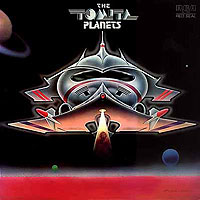 Claiming inspiration from the innovative orchestration of Rimsky-Korsakoff, Stravinsky and Ravel, his three earlier albums (Snowflakes are Falling – the Newest Sound of Debussy, Pictures at an Exhibition and Firebird) took their cues from Walter Carlos's 1968 Switched-On Bach by substituting electronic sounds for the actual instruments and thus generally respecting the structure and content of the originals. Here, while Tomita's Venus and Mars and the end of his Neptune are fairly tasteful if gimmicky adaptations, much of the rest at best is barely inspired by Holst, smothered under a din of rocket blasts, air-to-ground chatter, densely-packed crescendos and the like – musical mainly in the broad Cagian sense of expanding our traditional notions to include noise and natural sound. At least to my ears, the result here is more desecration than decoration of Holst's concept. (Please understand: I'm not a musical snob – beyond my recordings of serious music, I have (and enjoy!) 10,000+ blues, R&B, rock, jazz and pop 78s, 45s, LPs and CDs – and even some ragas, punk and rap. And let me also say that, out of an abundance of fairness and as a service to my dear readers, I did try to emulate its presumed target audience by listening again to the Tomita Planets while stoned but the effect seemed just as meaningless and pretentious – and way too long.)
Claiming inspiration from the innovative orchestration of Rimsky-Korsakoff, Stravinsky and Ravel, his three earlier albums (Snowflakes are Falling – the Newest Sound of Debussy, Pictures at an Exhibition and Firebird) took their cues from Walter Carlos's 1968 Switched-On Bach by substituting electronic sounds for the actual instruments and thus generally respecting the structure and content of the originals. Here, while Tomita's Venus and Mars and the end of his Neptune are fairly tasteful if gimmicky adaptations, much of the rest at best is barely inspired by Holst, smothered under a din of rocket blasts, air-to-ground chatter, densely-packed crescendos and the like – musical mainly in the broad Cagian sense of expanding our traditional notions to include noise and natural sound. At least to my ears, the result here is more desecration than decoration of Holst's concept. (Please understand: I'm not a musical snob – beyond my recordings of serious music, I have (and enjoy!) 10,000+ blues, R&B, rock, jazz and pop 78s, 45s, LPs and CDs – and even some ragas, punk and rap. And let me also say that, out of an abundance of fairness and as a service to my dear readers, I did try to emulate its presumed target audience by listening again to the Tomita Planets while stoned but the effect seemed just as meaningless and pretentious – and way too long.)
While critics at the time seemed divided along a predictable generational divide, one enthused that: "Holst might have really dug it." I truly doubt that! And yet ... While Tomita's structure seems mostly random and the nexus between the original and his contributions is often obscure, he does produce an impressive amount and array of fresh sound, and his abundant technical facility, sense of rhythm, feeling for spatial display and overall flair for invention are fully apparent. Perhaps Holst, who was devoted to searching for novel qualities among familiar instruments, would have been enthralled to hear textures beyond the reach of even his fertile imagination, limited as it was by the analog resources of his time. 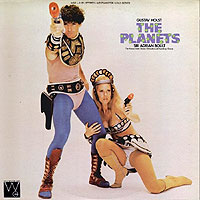 On his website Tomita lists a huge gamut of signal generators, oscillators, modulators, filters, phase shifters, mixers and more that were used to produce his Planets – rather ironically, more pieces of equipment than the number of instruments that would be used by a traditional orchestra to perform the original. But is the greater artist the one who briefly astonishes with unlimited resources, or another who extracts amazing things of lasting value from within the limits of the means he has on hand?
On his website Tomita lists a huge gamut of signal generators, oscillators, modulators, filters, phase shifters, mixers and more that were used to produce his Planets – rather ironically, more pieces of equipment than the number of instruments that would be used by a traditional orchestra to perform the original. But is the greater artist the one who briefly astonishes with unlimited resources, or another who extracts amazing things of lasting value from within the limits of the means he has on hand?
In a somewhat related development of pop culture, not only Williams's Star Wars but countless other sci-fi outer-space movie soundtracks have been (and still are being) derived from The Planets. But perhaps one of the earliest foretastes of that bond came with the 1970 reissue of the 1960 Boult/Vienna State Opera Orchestra Planets on Westminster Gold, a label known for metaphoric and often witty (if occasionally tasteless) covers that presumably strove to lure unwitting pop fans to the classics. Here they outdid themselves with a space-travel motif, capped with an overflowing bustier and lurid crotch shot. Yet if the cover managed to dupe a few kids into hearing some great music, it seemed at worst a victimless crime and, in the total scheme of things, a forgivable sin against artistic integrity.
 |
![]() While taking full responsibility for the musical judgments, I've done no independent research and gratefully acknowledge the following sources for the facts and quotations in this article:
While taking full responsibility for the musical judgments, I've done no independent research and gratefully acknowledge the following sources for the facts and quotations in this article:
- Boult, Sir Adrian: notes to his New Philharmonia LP (Angel S 36420, 1967)
- Crankshaw, Geoffrey: notes to the Marriner/Concertgebouw LP (Philips 950042, 1978)
- Foreman, Lewis: notes to the Elder/Hallé CD (Hyperion CDA 67270, 2001)
- Freed, Richard: notes to the Susskind/St. Louis LP (Turnabout QTV-S 34598, 1974)
- Greene, Richard: Holst – The Planets (Cambridge Music Handbook) (Cambridge University Press, 1995)
- Holbreich, Harry: notes to the Herrmann/London Philharmonic LP (Decca Phase 4 Stereo PFS 4184, 1970)
- Holst, Gustav: The Planets [orchestral score] (Boosey & Hawkes 15790, undated reprint of Goodwin & Tabb, 1921) available from the Petrucci Music Library
- Holst, Gustav: The Planets [two-piano score] (J. Curwen & Sons, 1979 reprint of 1949-51 initial publication of separate movements, with introduction by Imogen Holst), available from the Petrucci Music Library
- Holst, Imogen: notes to the Holst/London Symphony reissue LP (HMV Treasury HLM 7014, 1972)
- Hutchings, Arthur: "Music in Britain, 1918-1960" article in Martin Cooper, ed., The New Oxford Dictionary of Music, Volume X: The Modern Age (Oxford University Press, 1974)
- James, Burnett: notes to the Boult/Philharmonic Promenade LP (Nixa LP 903, 1954)
- Kennedy, Michael: notes to the Boult/BBC reissue LP (HMV Treasury ED 39 0725 (1986)
- Lee, Douglas: Masterworks of 20th Century Music (Routledge, 2002)
- Lyons, James: notes to the Steinberg/Boston LP (DG 2530 102, 1971)
- Matthew, Colin: "Holst" article in Stanley Sadie and John Tyrrell, eds., The New Grove Dictionary of Music and Musicians (Grove, 2001)
- Matthews, Colin: notes to the Elder/Hallé CD (Hyperion CDA 67270, 2001)
- Mullenger, Len: "HOLST Suite: The Planets" article on the Musicweb website
- Reid, James: “An Astronomer’s Guide to Holst’s The Planets,” (article in Sky and Telescope, January, 2011)
- Sanders, Alan: notes to the Holst Conducts Holst CD (Pearl GEMM 9451, 1999)
- Sargent, Malcolm: notes to his BBC LP (Capitol SG 7196, 1958)
- Schoenberg, Arnold [quoted in a Los Angeles Philharmonic program note by Herbert Glass for Five Pieces for Orchestra]
- Trippett, David: "A Biography of Gustav Holst, Part 3: 1915-1928" article on the Musicweb website
- Tuttle, Raymond: review of Judd/Royal Philharmonic Denon CD in Fanfare vol. 17 # 2 (November/December 1993)
- Ward, Benjamin [?]: biography and "The Planets" information on the Isao Tomita website
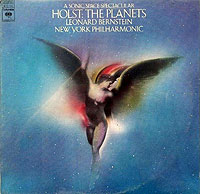 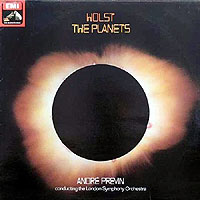
|
![]()
Copyright 2017 by Peter Gutmann
copyright © 1998–2017 by Peter Gutmann. All rights reserved.